

|
 |
Tenebrae AKA Tenebre AKA Unsane (Blu-ray)
Blu-ray B - United Kingdom - Arrow Films Review written by and copyright: Paul Lewis (17th December 2013). |
|
The Film
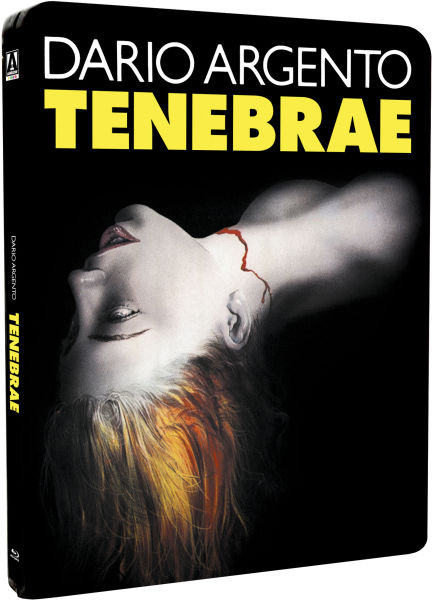 Tenebrae (Dario Argento, 1982)  Dario Argento’s Tenebre (Tenebrae/Unsane, 1982) is undoubtedly a major example of the 1980s thrilling all’italiana (‘Italian-style thriller’): the curiously Sadean thrillers whose template is often cited as Mario Bava’s Blood and Black Lace (Sei donne per l’assassino, 1964). Produced in Italy and experiencing its heyday in the 1960s and 1970s, the thrilling all’italiana was a major filone (‘stream’) within Italian cinema of the era, along with the western all’italiana (‘Italian-style Western’/Continental Western/‘Spaghetti’ Western), the poliziesco all’italiana (Italian-style police films, known pejoratively as poliziotteschi) and Gothic horror pictures. The thrilling all’italiana usually based itself around the narrative structure of the classic whodunit, adopted a nightmarish and baroque aesthetic, and foregrounded themes of sadistic spectacle and fetishised violence. These films are often referred to by English-speaking fans as gialli, although for Italian audiences the term giallo (plural: gialli) denotes any thriller, regardless of where it was produced: so for Italian audiences and critics, a Hitchcock film may be labeled a giallo. English fans usually use the term giallo in a slightly different way, to refer specifically to the curiously Italian thrillers associated with filmmakers like Mario Bava, Dario Argento, Sergio Martino and others. Dario Argento’s Tenebre (Tenebrae/Unsane, 1982) is undoubtedly a major example of the 1980s thrilling all’italiana (‘Italian-style thriller’): the curiously Sadean thrillers whose template is often cited as Mario Bava’s Blood and Black Lace (Sei donne per l’assassino, 1964). Produced in Italy and experiencing its heyday in the 1960s and 1970s, the thrilling all’italiana was a major filone (‘stream’) within Italian cinema of the era, along with the western all’italiana (‘Italian-style Western’/Continental Western/‘Spaghetti’ Western), the poliziesco all’italiana (Italian-style police films, known pejoratively as poliziotteschi) and Gothic horror pictures. The thrilling all’italiana usually based itself around the narrative structure of the classic whodunit, adopted a nightmarish and baroque aesthetic, and foregrounded themes of sadistic spectacle and fetishised violence. These films are often referred to by English-speaking fans as gialli, although for Italian audiences the term giallo (plural: gialli) denotes any thriller, regardless of where it was produced: so for Italian audiences and critics, a Hitchcock film may be labeled a giallo. English fans usually use the term giallo in a slightly different way, to refer specifically to the curiously Italian thrillers associated with filmmakers like Mario Bava, Dario Argento, Sergio Martino and others.
This confusion between how Italian audiences and English-speaking fans define the giallo is worth mentioning here, as the overlap and collision between English-language and Italian culture is a key theme of Tenebre. The film features an American writer of crime fiction, Peter Neal (Anthony Franciosa), who has arrived in Rome to promote his latest novel (bearing a Latin title, Tenebrae); the book has apparently become a best-seller in Italy and is described on its dust-jacket as ‘Il giallo dell'anno, forse del decennio’ (‘The thriller of the year, and perhaps the decade’). Neal becomes embroiled in a series of murders investigated by Inspector Germani (Giuliano Gemma), a detective who is curiously well-versed in the work of English crime writers Agatha Christie and Arthur Conan-Doyle. Germani is convinced that the murders are being committed in ‘tribute’ to Neal: the first victim is a young shoplifter, Elsa Manni (Ania Pieroni), who has stolen the novel and is found murdered in her home, pages from Tenebrae stuffed into her mouth. When arriving in Italy, Neal is forced to contend with the criticisms of his book as misogynistic trash (by feminist critic Tilde, played by Mirella d’Angelo), and misinterpretations of his novel as a text about the ‘elimination of perversion’ (by television interviewer Christiano Berti, played by John Steiner). Growing closer to his assistant Anne (Daria Nicolodi), Neal becomes further implicated in the murders as they strike closer to home: Tilde and her lover Marion (Mirella Banti) are both murdered, as are two of Neal’s young acquaintances – his assistant Gianni (Christian Borromeo) and Gianni’s sweetheart Maria (Lara Wendel). Meanwhile, Neal’s agent Bullmer (John Saxon) is conducting an affair with Neal’s bitter ex-lover Jane McKerrow (Veronica Lario). Neal takes it as a professional challenge, as a writer of whodunits, to work out the identity of the murderer and bring her or him to justice. It could be said that Tenebre has a curiously international flavour, although Argento’s films frequently feature American protagonists who are visiting/living in European countries and become embroiled in a mystery; in these films, the foreign nationality of these protagonists is used an index of their alienation. (Additionally, the casting of American and British actors probably made the films easier to sell to English-speaking territories, whilst the Italian settings gave the films a local identity for Italian audiences and, for English and American audiences, a slightly exotic sense of place.) Argento’s first film, The Bird with the Crystal Plumage (L’uccello dalle piume di cristallo, 1968) focuses on an American writer, Sam Dalmas (Tony Musante), who is living in Rome; likewise, his third film, Four Flies on Grey Velvet (Quattre mosche di velluto grigio, 1971) features an American protagonist, in this instance a drummer (Michael Brandon), who is also living in Rome. His second film, Cat O’Nine Tails (Il gatto a nove code, 1971) features an Italian protagonist, a journalist named Carlo Giordani, who is nevertheless played by the very American actor James Franciscus. In later films, this trope becomes more pronounced: Deep Red (Profondo rosso, 1974) features an English pianist, Marc Daly (David Hemmings), in Turin; Suspiria (1977) and Phenomena (1985) feature American students (Jessica Harper and Jennifer Connelly, respectively) in European locations. The most interesting deviation from this formula, Inferno (1980) focuses on an American student (Leigh McCloskey) in Rome who returns to his home city of New York following the disappearance of his sister (Irene Miracle). Argento does much to emphasise this sense of alienation and cultural dislocation in Tenebre. Like Suspiria, Tenebre opens with an airport: in the opening sequence of Suspiria, Suzy Banyon (Harper) is shown leaving a European airport (possibly meant to be either Stuttgart airport or Baden Airpark) after having alighted from an aeroplane; in the post-credits sequence of Tenebre, Neal is shown checking in to the airport in New York, receiving a telephone call from Jane at the check-in desk, and later arriving at the airport in Rome. Although the film was shot in Rome, Argento chose to depict the city in a very different way to which it is usually represented on film: Tenebre’s narrative takes place in spaces defined by angular, modernist architecture, the photography highlighting cold, clinical surfaces. Tenebre’s cinematographer, Luciano Tovoli, shot the film with clinical light: on the whole, the film is brightly lit, and Tovoli pushed the film stocks used during the production (Kodak Eastmancolor 5247/5293, rated 125ASA and 250ASA respectively) slightly, exposing them at 300ASA, thereby increasing contrast and colour saturation (and also subtly increasing the grain structure of these fine grain stocks). The aim was to emulate the aesthetic of Andrzej Zulawski’s Possession (1981), a film which Argento had admired very much (see Jones, 1996: 28). James Gracey defines the look of Tenebre as ‘cold, stark and futuristic’, with most sequences being very brightly lit ‘as though Argento were telling us that there is nowhere to hide from the darkness of the soul except in the darkest place of all: one’s own mind’ (2010: np). Argento himself wanted the film to look as if it were ‘a step into the world of tomorrow’, set ‘about five years in the future. It was never meant to be a story about something that is happening now and it doesn’t contain one shot of typical tourist Rome’ (Argento, quoted in Jones, op cit.: 29). In the society depicted in the film, Argento suggested, there are less people ‘with the result that the remainder are wealthier and less crowded [….] Something happened that made it that way but no one remembers or wants to remember’ (Argento, quoted in ibid.). 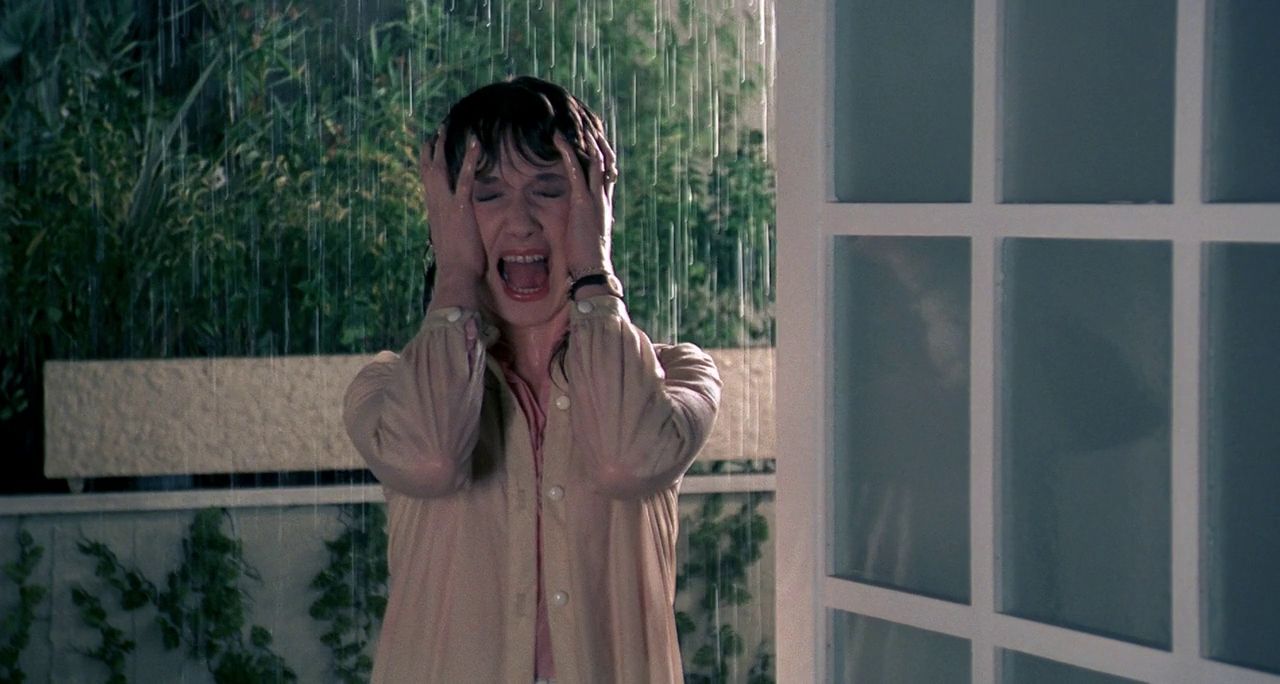 An intermittently brutal film, featuring an escalation of violence from the first relatively bloodless murder to the final sequence (which features an arm hacked off with an axe and unnaturally red arterial blood being sprayed across a white wall), Tenebre landed on the Director of Public Prosecution’s list of ‘video nasties’ in the build-up to the 1984 Video Recordings Act. (The Videomedia videocassette release which had been caught up in this moral panic was actually slightly censored, in the same way as the British cinema release, missing just under four seconds of footage during the sequence in which the arm is hacked off with an axe.) The crimes ultimately have little motivation, and Argento has claimed that he devised the film in response to the senseless violence he had witnessed during a holiday in Los Angeles. During the holiday, Argento learnt of a murder that took place in the lobby of the hotel in which he was staying; Argento also became aware of a drive-by shooting that took place outside a cinema, reflecting, ‘Why? Maybe this sort of violence does have a warped reasoning behind it, But just imagine if there wasn’t. It was precisely this sort of mythology that excited me and hopefully is contained in TENEBRAE’ (Argento, quoted in Jones, op cit.: 28-9; caps in original). During his stay in Los Angeles, Argento was also contacted via telephone by a deranged fan who threatened his life; Argento has commented that this event ‘seemed to me symptomatic of that city – the home of senseless violence. I wanted to put that sort of atmosphere in TENEBRAE. To kill for nothing says it all. If you kill for money or to achieve a goal, I can understand that [….] But when the gesture has no meaning, it’s more repugnant than ever’ (Argento, quoted in ibid.: 28). An intermittently brutal film, featuring an escalation of violence from the first relatively bloodless murder to the final sequence (which features an arm hacked off with an axe and unnaturally red arterial blood being sprayed across a white wall), Tenebre landed on the Director of Public Prosecution’s list of ‘video nasties’ in the build-up to the 1984 Video Recordings Act. (The Videomedia videocassette release which had been caught up in this moral panic was actually slightly censored, in the same way as the British cinema release, missing just under four seconds of footage during the sequence in which the arm is hacked off with an axe.) The crimes ultimately have little motivation, and Argento has claimed that he devised the film in response to the senseless violence he had witnessed during a holiday in Los Angeles. During the holiday, Argento learnt of a murder that took place in the lobby of the hotel in which he was staying; Argento also became aware of a drive-by shooting that took place outside a cinema, reflecting, ‘Why? Maybe this sort of violence does have a warped reasoning behind it, But just imagine if there wasn’t. It was precisely this sort of mythology that excited me and hopefully is contained in TENEBRAE’ (Argento, quoted in Jones, op cit.: 28-9; caps in original). During his stay in Los Angeles, Argento was also contacted via telephone by a deranged fan who threatened his life; Argento has commented that this event ‘seemed to me symptomatic of that city – the home of senseless violence. I wanted to put that sort of atmosphere in TENEBRAE. To kill for nothing says it all. If you kill for money or to achieve a goal, I can understand that [….] But when the gesture has no meaning, it’s more repugnant than ever’ (Argento, quoted in ibid.: 28).
Ellen Nerenberg suggests that Argento’s films are driven by the key themes of ‘[s]eeing and decoding clues, the work of detection (not to mention of semiotics and cinema studies)’ (2012: 82). Argento’s pictures often embed ‘clues in an obviously “artistic” structure that serves to frame knowledge, detection and, resolution’ (ibid.: 83). In The Bird with the Crystal Plumage, as he is passing a gallery with a glass front one evening, Sam Dalmas witnesses what seems to be an attempted murder; however, he becomes trapped between two sets of glass doors, unable to either intervene directly or to fetch help. The narrative returns to this scene obsessively as Dalmas seeks to decode it, obsessed with the idea that the clues to the crime (and the murders that have been plaguing Rome) lie in successfully interpreting what he saw that night. For Nerenberg, this particular ‘scene signifies misunderstanding and frustration, of seeing something but not believing it, and, importantly, seeing something but not trusting yourself to testify about it. Above all, the scene is about the difficulty of expressing what you believe you have witnessed’ (ibid.). Similar scenes recur throughout Argento’s examples of the thrilling subgenre: in Deep Red, Marc Daly’s witnessing of the death of a psychic (Macha Meril) is coloured by his belief that he has seen the murderer; in Cat O’Nine Tails, Franco Arno (Karl Malden) witnesses a murder, but he is blind and thus only has part of the puzzle. 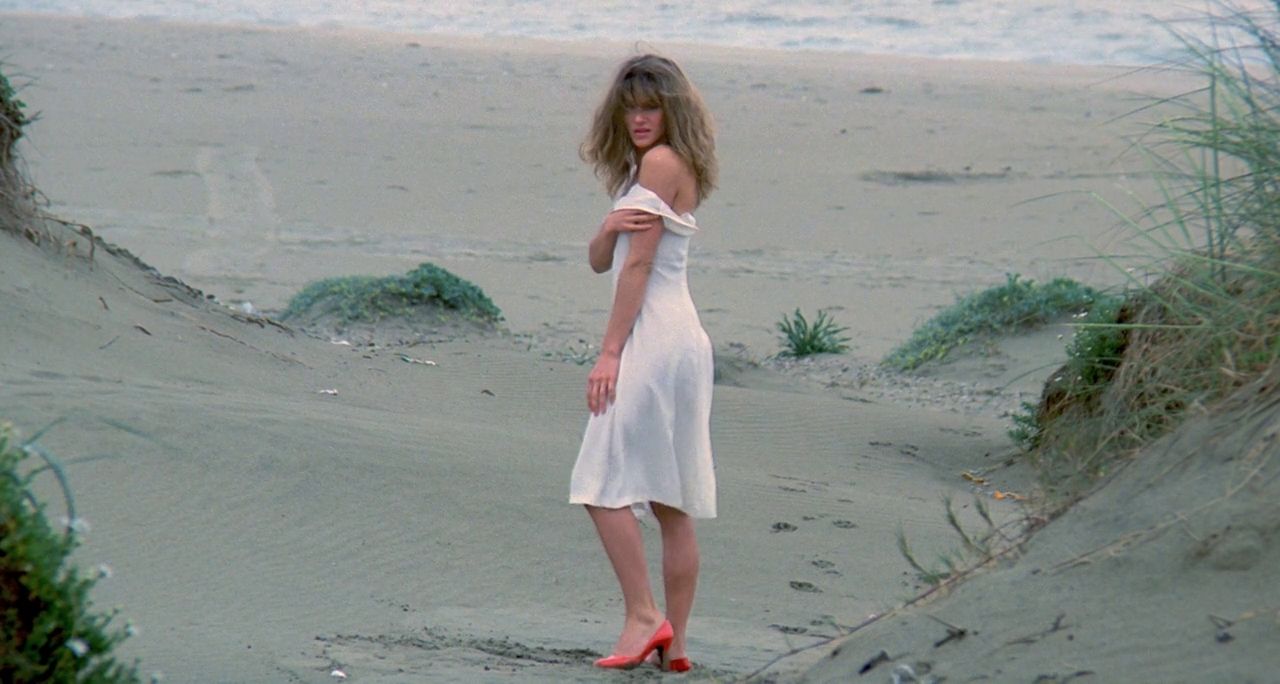 In Tenebre, this ‘primal scene’ to which the narrative insistently returns is a flashback, unanchored and adrift within the narrative, not tied to any specific character until the ‘reveal’ of the killer’s identity during the climax. The flashback depicts a scene of sexual humiliation on a beach. In the first of these flashbacks, a group of young men pursue an attractive young woman (played by the pre-operative transsexual actor Eva Robin’s (sic), whose androgynous charms had previously been foregrounded in the hardcore sex farce Eva Man, 1980). She submissively falls to her knees in front of the group, all of whom are dressed in white, before exploiting their desire by undressing. One of the men slaps her; she demonstrates her control of the group by commanding them to attack the boy. They hold him down whilst she humiliates him sexually, driving the red stiletto heel of her shoe into his mouth in an overt parody of the act of fellatio. In the second flashback, we see from the point-of-view of the humiliated young man as he takes his revenge, watching the young woman and her male suitor (Michele Soavi) from a distance before, after her suitor has left, approaching her and stabbing her in the stomach. The flashback ends as the young man steals the girl’s red stilettos, the symbol of his sexual humiliation. The iconography of these flashbacks recurs throughout the film: the vivid red of the stilettos is echoed visually by the crimson of the blood during the murder scenes and the red flowers within Jane McKerrow’s ultra-modernist house in Rome; an identical pair of red stilettos are presented to Jane as a gift, left on her doorstep in a giftwrapped box. The image of the blade entering the belly of the young woman is echoed in the sequence in which Bullmer is murdered in a shopping centre, a knife thrust into his abdomen in a similar point-of-view shot; and the image is reinforced later, during the climax, when a stainless steel sculpture pierces the stomach of the murderer. In Tenebre, this ‘primal scene’ to which the narrative insistently returns is a flashback, unanchored and adrift within the narrative, not tied to any specific character until the ‘reveal’ of the killer’s identity during the climax. The flashback depicts a scene of sexual humiliation on a beach. In the first of these flashbacks, a group of young men pursue an attractive young woman (played by the pre-operative transsexual actor Eva Robin’s (sic), whose androgynous charms had previously been foregrounded in the hardcore sex farce Eva Man, 1980). She submissively falls to her knees in front of the group, all of whom are dressed in white, before exploiting their desire by undressing. One of the men slaps her; she demonstrates her control of the group by commanding them to attack the boy. They hold him down whilst she humiliates him sexually, driving the red stiletto heel of her shoe into his mouth in an overt parody of the act of fellatio. In the second flashback, we see from the point-of-view of the humiliated young man as he takes his revenge, watching the young woman and her male suitor (Michele Soavi) from a distance before, after her suitor has left, approaching her and stabbing her in the stomach. The flashback ends as the young man steals the girl’s red stilettos, the symbol of his sexual humiliation. The iconography of these flashbacks recurs throughout the film: the vivid red of the stilettos is echoed visually by the crimson of the blood during the murder scenes and the red flowers within Jane McKerrow’s ultra-modernist house in Rome; an identical pair of red stilettos are presented to Jane as a gift, left on her doorstep in a giftwrapped box. The image of the blade entering the belly of the young woman is echoed in the sequence in which Bullmer is murdered in a shopping centre, a knife thrust into his abdomen in a similar point-of-view shot; and the image is reinforced later, during the climax, when a stainless steel sculpture pierces the stomach of the murderer.
The film is laced with irony and may be interpreted as a bold piece of metafiction. Through the depiction of an author, Neal, who is challenged by Tilde for his depiction of women as ciphers and victims, and misinterpreted by Berti as validating the agenda of the murderer in his novel, Argento seems to address the criticisms and accusations of misogyny that are from time to time directed towards his own work. When Neal first meets with the press, Tilde ambushes him, asserting that ‘Tenebrae is a sexist novel. Why do you despise women so much?’ Neal’s response to this is to assert that ‘You’ve known me for ten years, ever since you studied in New York, Tilde’. ‘Look, I’m talking about your work’, Tilde pleads, separating the art from the artist. (The relationship between Tilde and Neal is unclear: they clearly know one another, with Neal apparently having met Tilde whilst she studied in New York; however, it’s said that this is Neal’s first visit to Rome, but Tilde tells him that her ‘mother was hoping you’d call’.) Tilde, the feminist critic, is depicted somewhat stereotypically: she is gay and, we are led to believe, somewhat repressed. (Her lover, Marion, is bisexual, and when Marion spends the night with a male acquaintance, Tilde’s jealousy is emphasised.) After Tilde has ‘ambushed’ Neal, Bullmer takes him aside and, in a comment that speaks to Bullmer’s brusque character, offers him advice: ‘Those dykes want your balls because they haven’t got their own’. Later, in a line of dialogue that perhaps speaks to how Argento at the time felt about some of the criticisms of his own work, Bullmer informs Neal that ‘They love your books, but they hate success’. Later, when he is confronted by Germani after the murder of Elsa Manni has been discovered, Neal comments dryly, ‘Listen, if someone is killed with a Smith and Wesson revolver, do you go and interview the president of Smith and Wesson?’ However, the communications Neal receives from the killer establish his complicity in the crimes from the get-go: ‘You taught me how, Peter Neal’, the killer taunts during his first telephone call to Neal: ‘You and me together: we’ve only just begun’.
Video
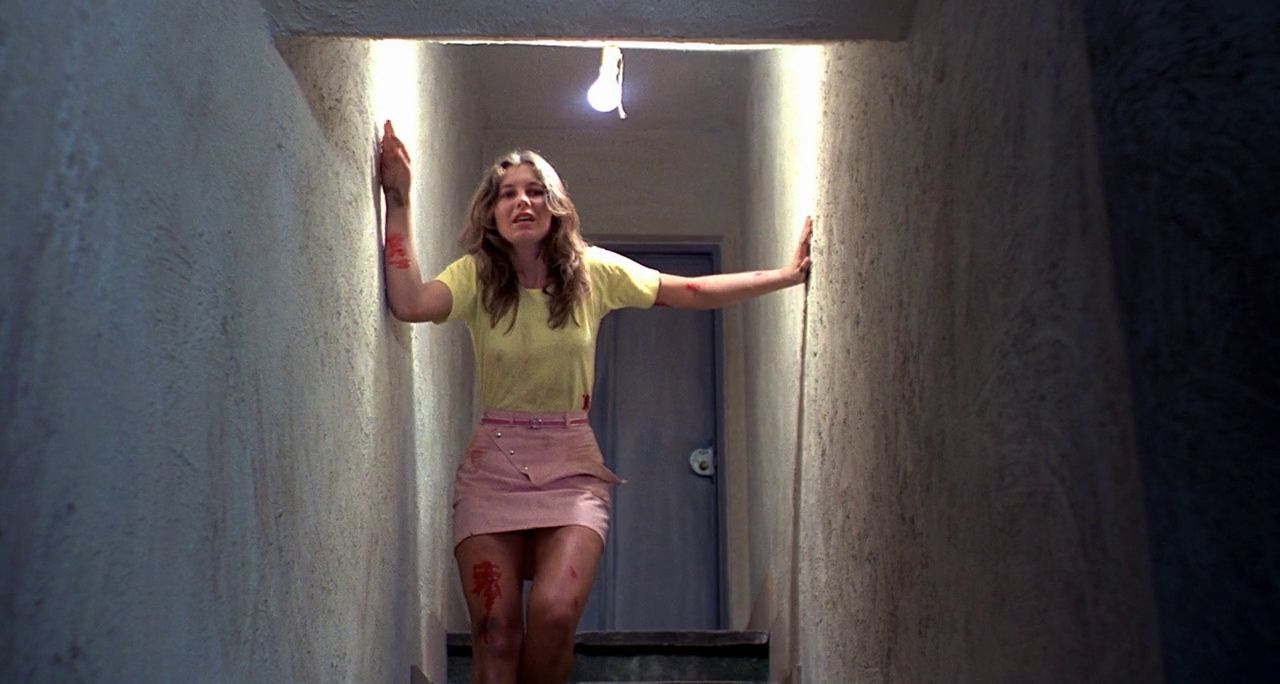 Tenebre has had a somewhat chequered history on digital home video formats. Anchor Bay’s American DVD release, in 1999, was uncut in terms of violent content but missing about half a minute of narrative footage – as per the previous LaserDisc release from the Roan Group. Several subsequent DVD releases used the same source print, and were also missing these thirty seconds or so. Tenebre has had a somewhat chequered history on digital home video formats. Anchor Bay’s American DVD release, in 1999, was uncut in terms of violent content but missing about half a minute of narrative footage – as per the previous LaserDisc release from the Roan Group. Several subsequent DVD releases used the same source print, and were also missing these thirty seconds or so.
Arrow’s first Blu-ray release of Tenebrae (in 2011) contained an uncut version of the film, including the seconds missing from a number of its previous DVD incarnations, but was frustrating in terms of the presentation of the film. The transfer was plagued with what has since been claimed to be noise produced by a poorly-calibrated/poorly-maintained CRT telecine machine that was used in the transferring of the film elements. This resulted in a strange, unnatural grain structure. This release was compared unfavourably with an already-available French Blu-ray release from Wild Side Video, which appeared in 2010; the Wild Side Blu-ray was based on a different transfer and had a much cleaner, more natural and filmlike appearance. However, the Wild Side Video release featured forced French subtitles on both the Italian and English language tracks. This new ‘remastered edition’ from Arrow, for the time being available exclusively through online retailer Zavvi, is based on the same transfer as the Wild Side disc but seems to feature a very slightly more robust encode. The differences between this release and the Wild Side disc are negligible, but in terms of the presentation of the film this remastered release is head and shoulders above Arrow’s previous Blu-ray release. The 1080p presentation (using the AVC codec) has a filmlike appearance, with a natural sheen of film grain (befitting the 125 speed film, pushed to 300ASA, that makes up the bulk of the film). The opening titles have an odd look to them that seems to be a product of the optical printing/composition process. Contrast is strong throughout, as per the Wild Side presentation. This is a very pleasing presentation, easily eclipsing Arrow’s previous Blu-ray release, and for the time being representing the best English-friendly HD release of this title. NB. The images in this review are for illustration purposes only and are not intended to reflect the quality of the transfer on this Blu-ray release.
Audio
Two audio options are available: an English LPCM 2.0 mono track and an Italian LPCM 2.0 mono track. Both of these are clean and clear. Arrow have also seen fit to include English subtitles for both of these tracks: the subtitles for the Italian track are based on a translation of the Italian dialogue (rather than being ‘dubtitles’). Although the film, like many Italian genre pictures of the era, was shot with post-synched sound and most of the cast dubbing their own lines in the English track (with the notable exception of Daria Nicolodi, who was dubbed in the English version by Theresa Russell), as with a number of Argento’s films the Italian track features a slightly different, arguably more atmospheric, sound mix that foregrounds some of the ambient diegetic sounds that are buried in the English track’s mix. In the Italian track, the opening narration (lines from Neal’s novel Tenebrae: 'The impulse had become irresistible. There was only one answer to the fury that tortured him. And so he committed his first act of murder') is delivered by Argento himself, and the Italian track also features some interesting differences in terms of dialogue. During the murder of Elsa Manni, in the English version the killer calls her ‘Thief’ as he stuffs pages from Tenebrae into her mouth; in the Italian version, the killer says, ‘It’s time to die’. In the English version, when Germani and his assistant Altieri (Carola Stagnaro) fail to catch the killer outside Neal’s hotel, Germani comments to Altieri, ‘I should have a tough male sidekick who runs fast’. Altieri responds, ‘You’d hate it. You’d have nothing to bitch about’. In the Italian version, her response is slightly different: ‘Who would you have a go at then?’, she asks.
Extras
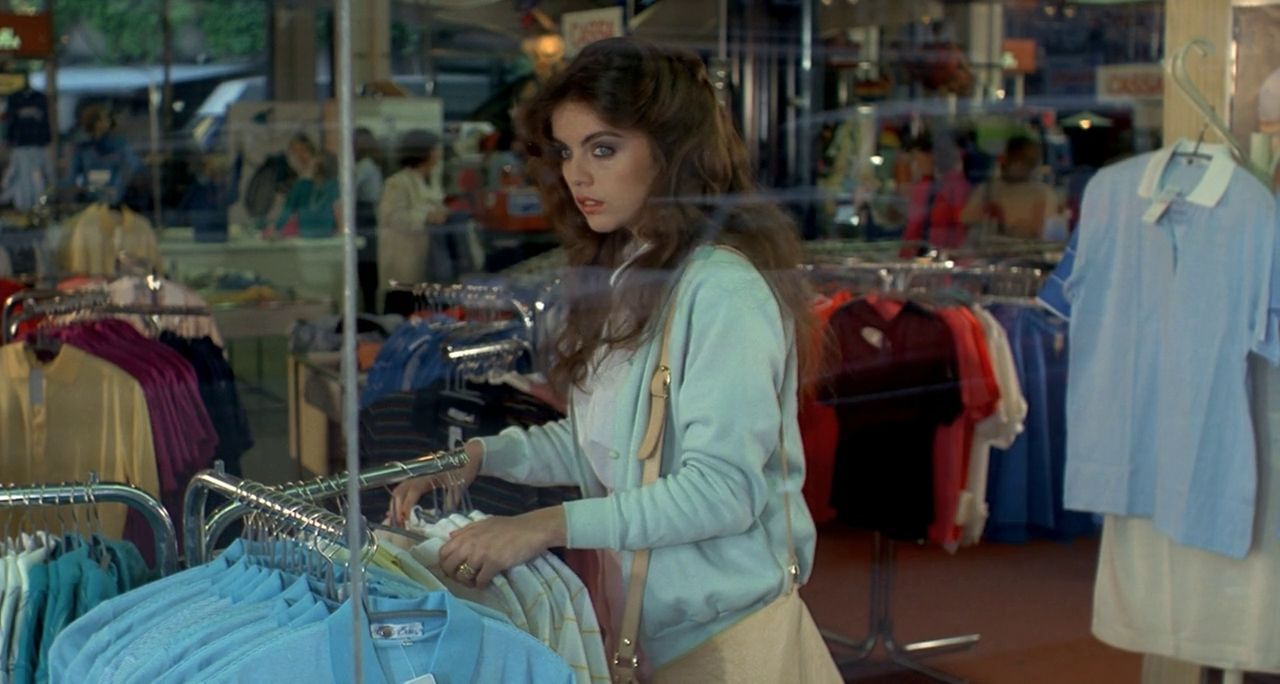 The release contains two audio commentaries: the first is a lively track featuring Alan Jones and Kim Newman, which offers much personal insight from Jones (whose association with Argento has been long-documented) and enthusiasm for the film from both participants; the second is a slightly dry commentary from Thomas Rostock, which delivers some insightful analysis of the film but often resorts to describing the action taking place on screen. (This second audio commentary is also slightly unclear, having apparently been recorded on a low-end microphone and sometimes being drowned out by the music and sound from the film itself.) The release contains two audio commentaries: the first is a lively track featuring Alan Jones and Kim Newman, which offers much personal insight from Jones (whose association with Argento has been long-documented) and enthusiasm for the film from both participants; the second is a slightly dry commentary from Thomas Rostock, which delivers some insightful analysis of the film but often resorts to describing the action taking place on screen. (This second audio commentary is also slightly unclear, having apparently been recorded on a low-end microphone and sometimes being drowned out by the music and sound from the film itself.)
The disc also contains an optional introduction to the film from Daria Nicolodi (10 seconds) and three featurettes: - 'Screaming Queen! Daria Nicolodi remembers Tenebrae' (HD, 16:9) (16:04); - 'The Unsane World of Tenebrae: An Interview with Dario Argento' (HD, 16:9) (15:13); - 'A Composition for Carnage: Claudio Simonetti on Tenebrae' (HD, 16:9) (10:04). 'Goblin: Tenebrae and Phenomena - Live from the Glasgow Archives, 2011' (HD, 16:9) (16:37) features a performance of tracks from the soundtrack for Tenebre. 'Maitland McDonagh on Tenebrae' (HD, 16:9) (12:20) is an interview with Maitland McDonagh, the author of Broken Mirrors/Broken Minds: The Dark Dreams of Dario Argento. This interview with McDonagh, insightful in highlighting the major themes of the film, is new to this release and was not included on Arrow’s previous Blu-ray. Finally, the disc also includes the film’s trailer (HD, 16:9) (3:14).
Overall
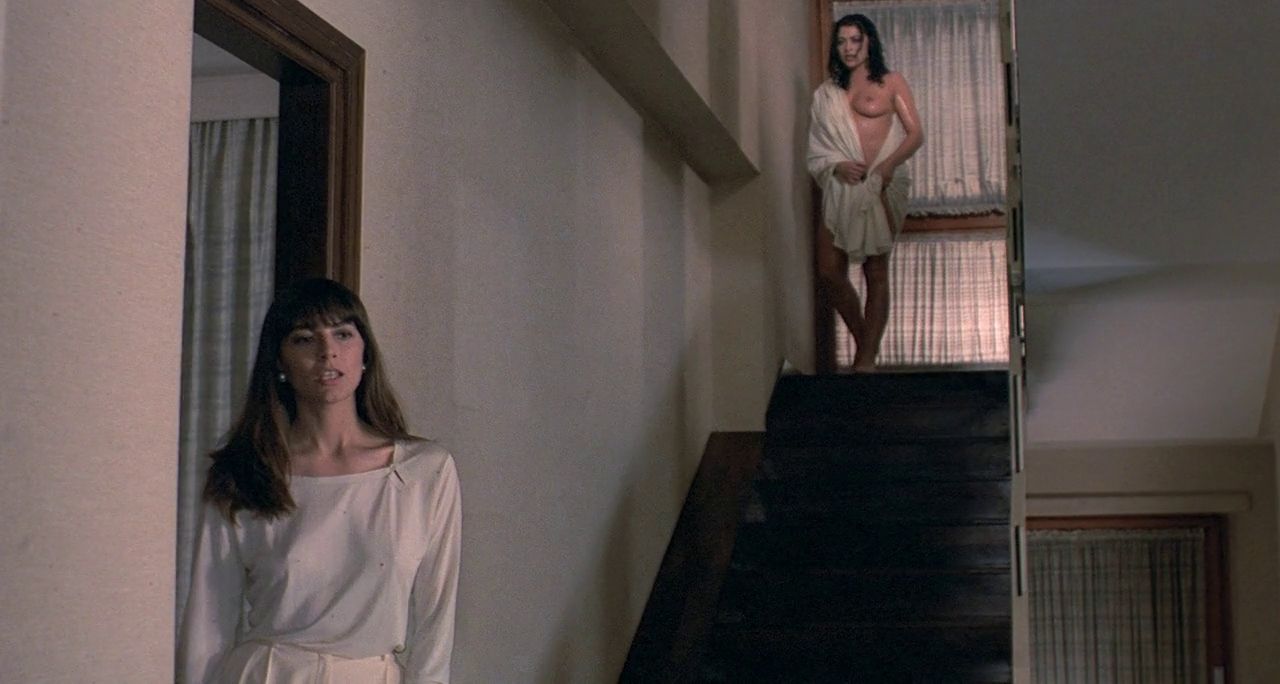 A fascinating example of the thrilling all’italiana, Tenebre is also arguably one of Argento’s best films. There’s much food for thought here: as noted above, the film may be approached as a piece of metafiction, offering ironic commentary on the criticisms that had been made against some of Argento’s previous films. The thriller plot works nicely, and the film is very well-shot and edited: a highlight is the bravura Louma crane shot that has been much discussed in the literature that has been published on the film, but this shot is preceded by an equally interesting shot: a long take in which Tilde and Marion square off against one another following Marion’s one-night stand with a young man from the local bar, Tilde in focus in the foreground, a near-naked Marion (clad only in a towel) standing at the top of the stairs and taunting Tilde with comments about her male lover’s sexual prowess (‘He was magnificent!’). Eventually, the pair go their separate ways: Marion returns upstairs to the bedroom, whilst Tilde remains downstairs and enters another room, the camera (still in the same shot) dollying after her. A fascinating example of the thrilling all’italiana, Tenebre is also arguably one of Argento’s best films. There’s much food for thought here: as noted above, the film may be approached as a piece of metafiction, offering ironic commentary on the criticisms that had been made against some of Argento’s previous films. The thriller plot works nicely, and the film is very well-shot and edited: a highlight is the bravura Louma crane shot that has been much discussed in the literature that has been published on the film, but this shot is preceded by an equally interesting shot: a long take in which Tilde and Marion square off against one another following Marion’s one-night stand with a young man from the local bar, Tilde in focus in the foreground, a near-naked Marion (clad only in a towel) standing at the top of the stairs and taunting Tilde with comments about her male lover’s sexual prowess (‘He was magnificent!’). Eventually, the pair go their separate ways: Marion returns upstairs to the bedroom, whilst Tilde remains downstairs and enters another room, the camera (still in the same shot) dollying after her.
Another delight in the film is Argento’s blackly comic depiction of authority figures. When Germani arrives at Neal’s hotel room, Anne offers him a drink before remembering ‘You don’t drink on duty’. ‘I only drink on duty’, Germani responds. Argento also inserts an amusing, ironic bit of business with Bullmer’s hat. ‘Doesn’t it drop off? [.…] You know, if you make a quick movement?’, Neal asks Bullmer upon arriving at the airport in Rome and seeing Bullmer’s new trilby for the first time. Bullmer responds in the negative and gives Neal a little demonstration, whipping his head quickly in a circle to show that it does not fall off. However, during the sequence in which Bullmer is murdered, as he is stabbed in the abdomen, his head whips back and his hat falls from his head. This presentation of Tenebre is easily the equal of the Wild Side Blu-ray and is a huge improvement on Arrow’s previous Blu-ray release. This release also includes a strong array of contextual material and, just as interestingly, English subtitles for the Italian track. Arrow’s remastered release of Tenebre represents the best release currently on the market of this film, one of Argento’s best and a shining example of the thrilling all’italiana. References: Bondanella, Peter, 2009: A History of Italian Cinema. London: Continuum Cooper, L Andrew, 2012: Contemporary Film Directors: Dario Argento. University of Illinois Press Gracey, James, 2010: Dario Argento. London: Kamera Books Jones, Alan, 1996: Mondo Argento. Upton, Cambridgeshire: Midnight Media McDonagh, Maitland, 1991: Broken Mirrors/Broken Minds: The Dark Dreams of Dario Argento. London: sun tavern fields Nerenberg, Ellen, 2012: Murder Made in Italy: Homicide, Media, and Contemporary Italian Culture. Indiana University Press
|
|||||

|